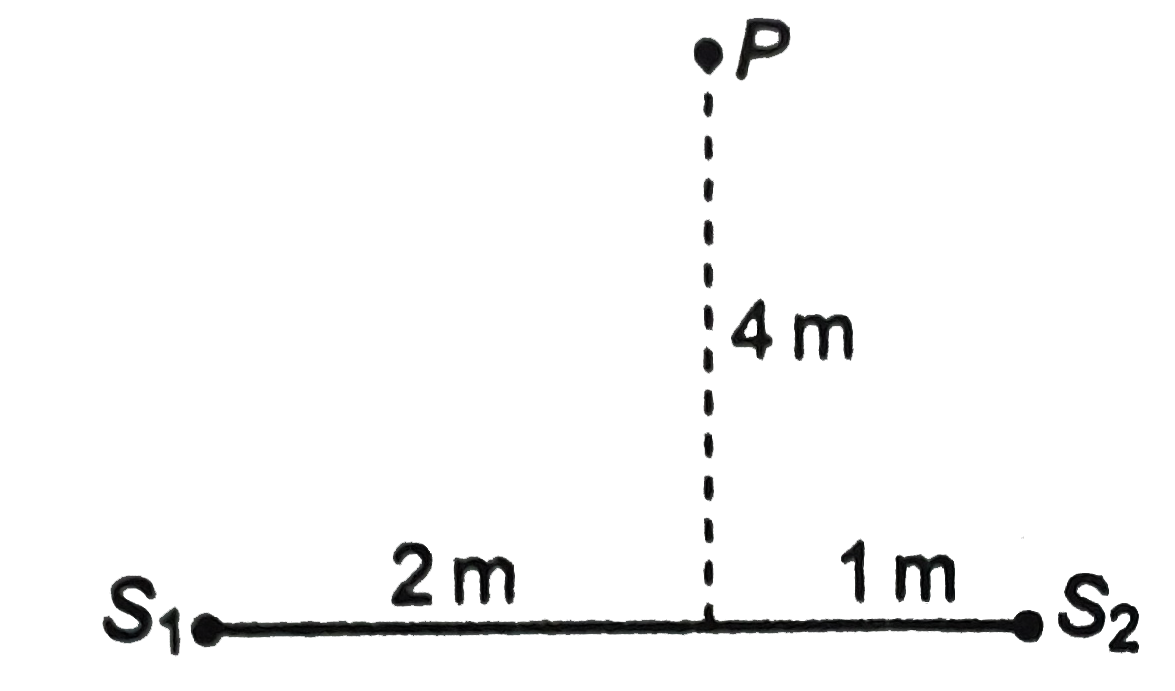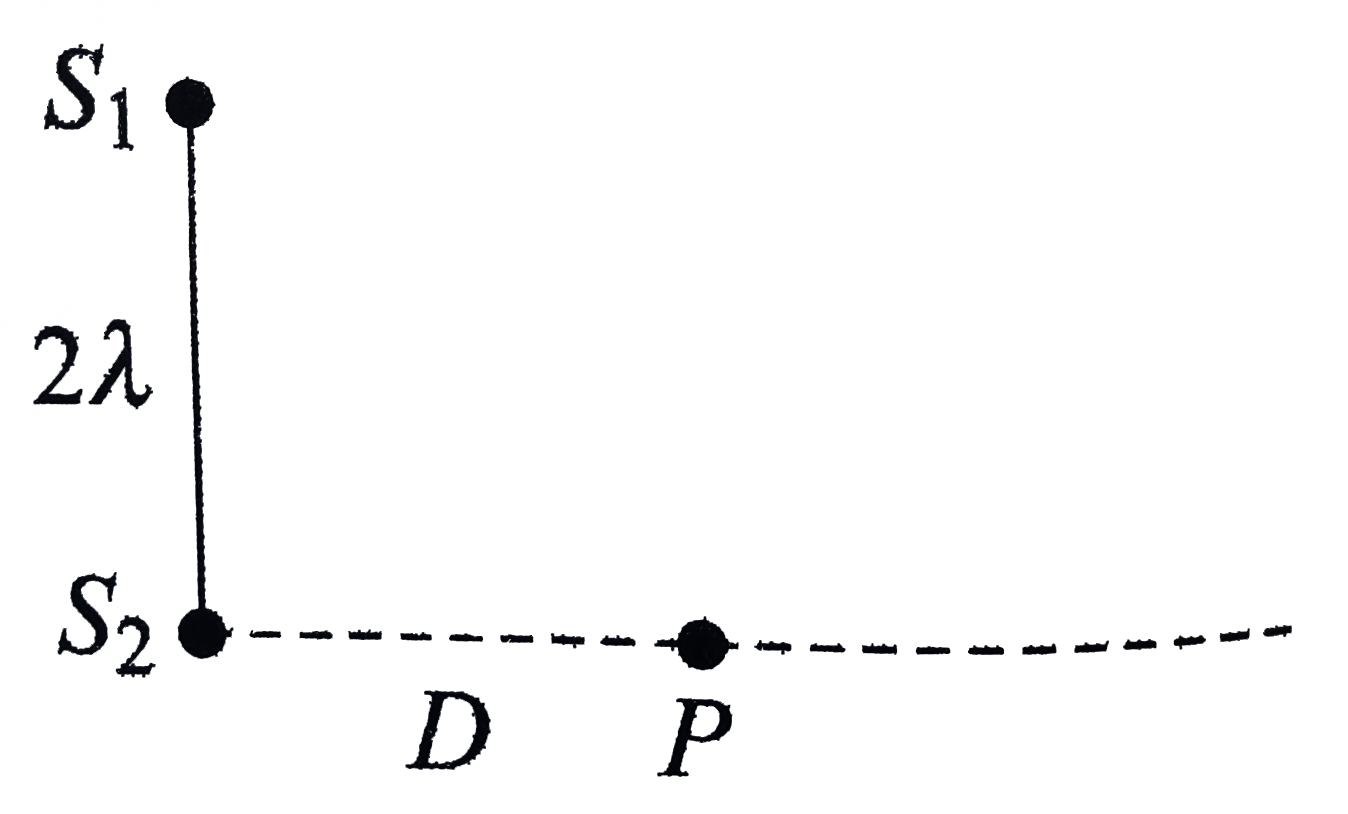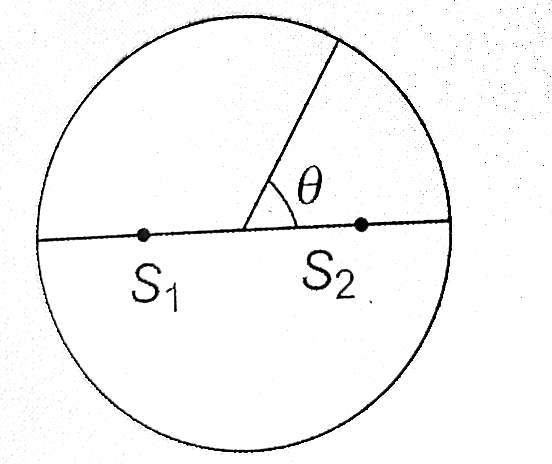Ratio waves originating from sources S1 and S2 having zero phase difference and common wavelength λ will show completely destructive interference at a point P is S1P−S2P is
5λ
2λ
3λ4
11λ2
The correct Answer is:D
To solve the problem, we need to determine the path difference between the two waves originating from sources S1 and S2 at point P that results in completely destructive interference.
1. Understanding Destructive Interference:
- Destructive interference occurs when two waves meet in such a way that their crests and troughs cancel each other out. This happens when the phase difference between the two waves is an odd multiple of π (180 degrees).
- Mathematically, for two waves to interfere destructively, the path difference must be given by:
Δd=S1P−S2P=(n+12)λ
where n is an integer (0, 1, 2, ...).
2. Common Wavelength:
- Given that both sources have a common wavelength λ, we can use this in our calculations.
3. Condition for Complete Destructive Interference:
- For complete destructive interference, we need the path difference to be equal to an odd multiple of half the wavelength:
S1P−S2P=(n+12)λ
- The simplest case (for n=0) gives:
S1P−S2P=12λ
4. Conclusion:
- Therefore, the path difference S1P−S2P must be equal to 12λ for the waves from sources S1 and S2 to show completely destructive interference at point P.
Final Answer:
The path difference S1P−S2P for completely destructive interference is:
S1P−S2P=12λ
- Destructive interference occurs when two waves meet in such a way that their crests and troughs cancel each other out. This happens when the phase difference between the two waves is an odd multiple of π (180 degrees).
- Mathematically, for two waves to interfere destructively, the path difference must be given by:
Δd=S1P−S2P=(n+12)λ
where n is an integer (0, 1, 2, ...).
- Given that both sources have a common wavelength λ, we can use this in our calculations.
- For complete destructive interference, we need the path difference to be equal to an odd multiple of half the wavelength:
S1P−S2P=(n+12)λ
- The simplest case (for n=0) gives:
S1P−S2P=12λ
- Therefore, the path difference S1P−S2P must be equal to 12λ for the waves from sources S1 and S2 to show completely destructive interference at point P.
The path difference S1P−S2P for completely destructive interference is:
S1P−S2P=12λ
Topper's Solved these Questions
Similar Questions
In a modified set up of Young's double slit experiment, it is given that SS2−SS1=λ4 i.e., the source S is not equidistant from the slits S1andS2.
(a) Obtain the condition for constructive and destructive interference at any point P on the screen in terms of the path difference Δ=S2P−S1P.
(b) Does the observed central bright fringe lie above or below O ? Give reason in support of your answer.View SolutionTwo sound sources S1 and S2 emit pure sinussoidal waves in phase . If the speed of sound is 350m/s , then

(a) for what frequencies does constructive interference occur at point P ?
(b) for what frequencies does destructive interference occur at point P ?View Solution
Knowledge Check
- Question 1 - Select One
In the case of light waves from two coherent sources S1 and S2, there will be constructive interference at an arbitrary point P, the path difference S1P−S2P is
A(n+12)λBnλC(n−12)λDλ2 - Question 2 - Select One
In experimental set up of interference the twol interfering sources S1andS2 have an initial phase difference corresponding to a path difference of λ/4. The phase difference due to path difference between the twoll interfering waves at a point of constructive and destructive interference respectively is
A(2n−1)π2,(2n+1)πB(2n−1)π,(2n+1)π2C(2n−1)π,(2n+1/2)πD(2n+1/2)π,(2n−1/2)π - Question 3 - Select One
Consider two coherent, monochromatic (wavelength λ) sources S1andS2, separated by a distance d. The ratio of intensities of S1 and that of S2 (which is responsible for interference at point P, where detector is located) is 4. The distance of point P from S1 is (if the resultant intensity at point P is equal to 94 times of intensity of S1) (Given : ∠S2S1P=90∘,d>0andn is a positive integer)
Ad2−n2λ22nλBd2+n2λ22nλCnλd√d2−n2λ2D2nλd√d2−n2λ2
Two coherent point sources S1 and S2 vibrating in phase emit light of wavelength λ. The separation between the sources is 2λ. Consider a line passing through S1 and perpendicular to line S1S2. Find the position of farthest and nearest minima.
 .View Solution
.View SolutionFigure shows two coherent sources S1 and S2 which emit sound of wavelength λ in phase. The separation between the sources is 3λ. A circular wire of large radius is placed in such a way that S1S2 lies in its plane and the middle point of S1S2 is at the centre of the wire. Find the angular positions θ, on the wire for which constructive interference takes place.
 View Solution
View SolutionIn Fig. , two point sources S1 and S2 which are in phase and separated by distance D=1.5λ , emit identical sound waves of wavelength λ.
(a) What is the path length difference of the waves from S1 and S2 at point P1, which lies on the perpendicular bisector of distance D, at a distance greater than D from the sources ? (That is, what is the difference in the distance from source S1 to point P1 and the distance from source S2 to P1?) What type of interference occurs at P1 ?
(b) What are the path length difference and type of interference at point P2 in fig.
(c ) Figure shows a circle with a radius much greater than D, centered on the midpoint between sources S1 and S2. What is the number of points N around this circle at which the interference is fully constructive? (That is, at how many points do the waves arrive exactly in phase?)View SolutionAt two point P and Q on screen in Young's double slit experiment, waves from slits S1 and S2 have a path difference of 0 and λ4 respectively. The ratio of intensities at P and Q will be:
View SolutionTwo monochromatic coherent point sources S1 and S2 are separated by a distance L. Each sources emits light of wavelength λ, where L>>λ. The line S1S2 when extended meets a screen perpendicular to it at point A. Then
View Solution

